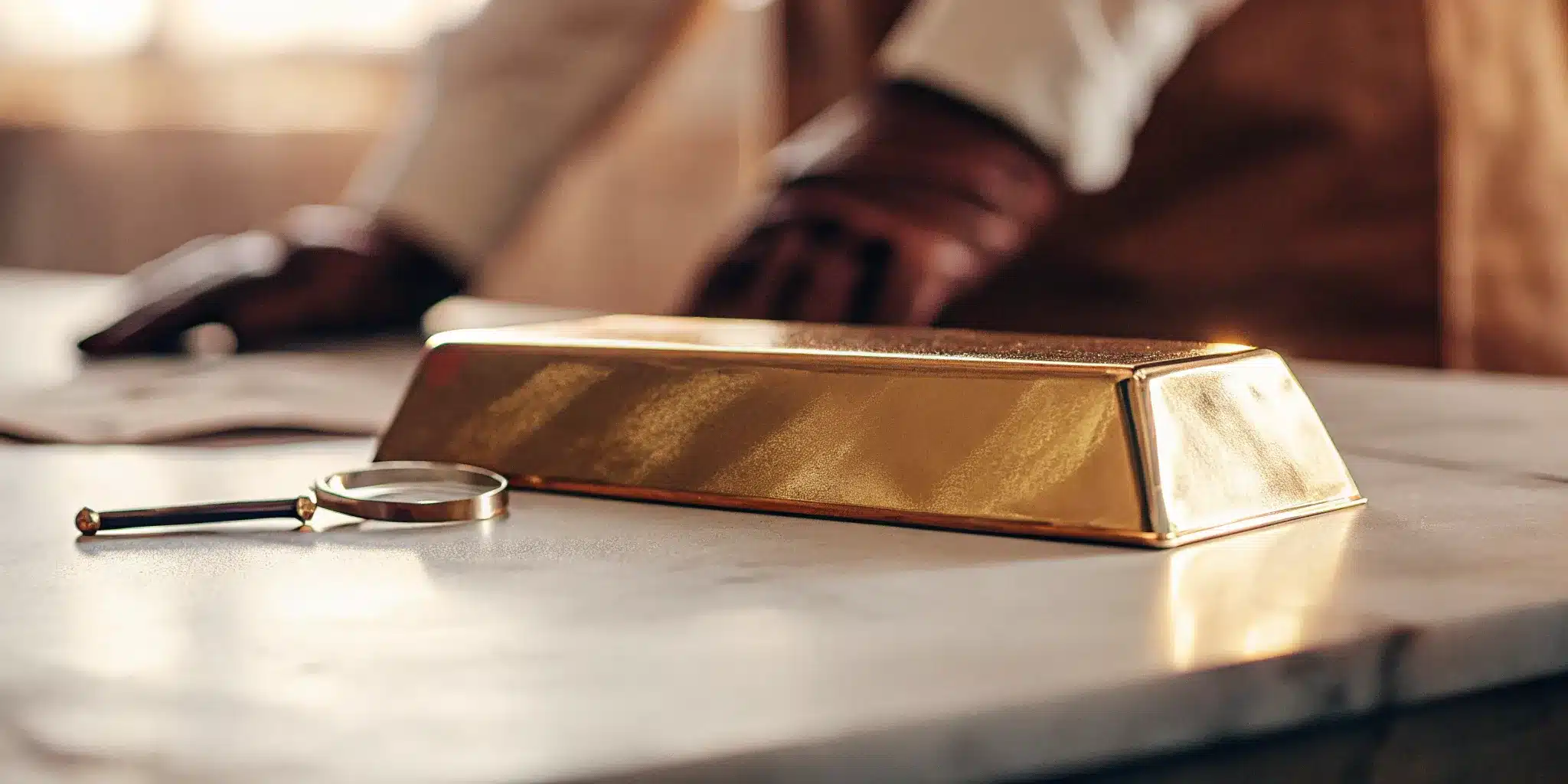Beyond the price charts and market hype, what are you actually owning when you invest in Bitcoin or gold? One is a tangible piece of history, a physical metal you can hold in your hand. The other is a piece of a decentralized digital network, secured by cryptography and existing only online. The Bitcoin vs Gold debate forces us to think about what gives an asset value in the first place—is it physical scarcity and industrial use, or is it digital scarcity and a revolutionary technology? Before you decide where to put your money, it’s essential to understand the fundamental nature of what you are buying.
Key Takeaways
- Align Your Choice with Your Risk Tolerance: The right asset depends on your financial goals. Gold’s stability is better for wealth preservation and lower-risk strategies, while Bitcoin’s high volatility offers greater growth potential for those comfortable with more aggressive risk.
- Understand What You’re Actually Owning: Gold is a physical commodity with a long history and clear regulations, making it a traditional safe haven. Bitcoin is a newer digital asset with an evolving legal framework, meaning its risk profile is tied to technology adoption and future rules.
- Use Both to Create a Balanced Portfolio: You don’t have to pick a side. Combining these assets can be a smart diversification strategy, using gold’s stability to anchor your portfolio against Bitcoin’s volatility while still capturing the potential upside of digital currency.
Bitcoin vs. Gold: What Are You Investing In?
When you’re looking to protect and grow your wealth, the conversation often turns to two major players: gold and Bitcoin. One is an ancient symbol of wealth, tangible and trusted for millennia. The other is a digital pioneer, challenging our very definition of money. While both are seen as alternatives to traditional currencies, they are fundamentally different assets. Understanding what makes each one unique is the first step in deciding where your capital should go. Let’s break down what you’re really getting when you invest in either gold or Bitcoin.
Core Similarities and Differences
At first glance, gold and Bitcoin share a key purpose: many people use them as stores of value to hedge against inflation and economic turbulence. This is where their paths start to diverge. Gold is a physical asset you can hold, with a history stretching back thousands of years. It also has practical uses in industries like jewelry and electronics, which helps stabilize its demand. Bitcoin, on the other hand, is entirely digital. It exists on a decentralized network, with its main appeal being its limited supply of 21 million coins and its ease of transfer across borders without a middleman.
Their History and Market Behavior
Gold’s long history gives it a reputation for resilience. It has maintained its value through centuries of wars, recessions, and financial crises, earning its title as a reliable safe-haven asset. Bitcoin is the new kid on the block. While it has shown potential as a modern hedge, its history is much shorter and far more dramatic. Bitcoin’s market behavior is defined by high volatility, with prices that can experience massive swings in relatively short periods. While this volatility can create opportunities for significant gains, it also introduces a higher level of risk compared to gold’s slow and steady nature.
How Do They Perform Under Pressure?
When markets get rocky, investors look for assets that can weather the storm. The goal is to find a “safe haven”—an investment that is expected to retain or even increase in value during times of market turbulence. For centuries, gold was the undisputed champion in this arena. It’s the asset your grandparents probably trusted to hold its value no matter what was happening in the world, from recessions to geopolitical conflicts. Its long-standing reputation is built on a foundation of physical scarcity and universal acceptance.
But now, there’s a new contender challenging that throne. Bitcoin has emerged as a digital alternative, with many proponents arguing it serves a similar purpose in a modern portfolio. They point to its decentralized nature and fixed supply as key features that make it resistant to inflation and government interference. While both assets are seen as hedges against uncertainty, they behave very differently under pressure. Understanding these differences is key to deciding which one, if any, belongs in your investment strategy. Let’s break down how each asset has historically performed when the pressure is on.
Gold: The Traditional Safe Haven
Gold has a long and storied history as a reliable store of value, especially during recessions. Its reputation is built on thousands of years of being used as currency and a symbol of wealth. Because it’s a physical asset with uses in jewelry, electronics, and even dentistry, its value isn’t based purely on speculation. This gives it a stable floor that purely digital assets lack. During times of crisis, investors have consistently turned to gold to preserve their wealth, and it has historically held its ground when stock markets have faltered. This track record makes it a cornerstone for conservative investors focused on capital preservation.
Bitcoin: A Modern Hedge Against Uncertainty?
Bitcoin is increasingly seen by some investors as “digital gold,” a modern hedge against economic instability and inflation. Its appeal comes from its decentralized nature and a fixed supply of 21 million coins, which creates scarcity similar to a precious metal. During the economic uncertainty of the COVID-19 pandemic, for instance, Bitcoin attracted significant attention as an alternative to traditional assets. However, it’s crucial to recognize that Bitcoin’s price is famously volatile and can be heavily influenced by market sentiment, regulatory news, and even social media trends. While it has the potential for high returns, it also carries a much higher risk profile than gold.
Weighing the Risks and Rewards
Every investment comes with its own risk-reward profile, and the difference between Bitcoin and gold is night and day. Understanding their distinct behaviors is the first step toward deciding where your money should go. While one offers the potential for explosive growth, the other provides a sense of stability that has been trusted for centuries. Your choice depends entirely on your financial goals and how much risk you’re comfortable taking on.
At FN Capital, we believe in making informed decisions based on clear data. Our FAST AI system is built to manage risk in the forex market, but the principles of weighing potential outcomes apply to every asset class. Let’s break down what you can expect from Bitcoin and gold.
The High Volatility of Bitcoin
Bitcoin is famous for its dramatic price swings. Unlike assets tied to company performance, its value is driven almost entirely by investor sentiment. This makes it a classic double-edged sword, offering both high returns and incredibly high risk. For some, the thrill of a potential windfall is worth the uncertainty. For others, the lack of predictability is a major drawback.
Between 2020 and 2024, Bitcoin’s price journey was a rollercoaster, soaring above $69,000 before dropping below $20,000, only to climb again. This kind of volatility can create massive gains for investors who time the market perfectly, but it can also lead to significant losses. It’s a high-stakes environment where fortunes can be made or lost in a short period, a stark contrast to strategies focused on risk mitigation.
The Steady Nature of Gold
On the other side of the spectrum is gold, which has a long-standing reputation as a reliable store of value. For generations, investors have turned to gold to protect their wealth, especially during times of economic instability or recession. While it doesn’t typically offer the explosive returns of a volatile asset like Bitcoin, its stability is its main appeal. It’s less about getting rich quick and more about preserving the wealth you already have.
Gold has historically held its value even during major financial crises, earning its title as a safe haven asset. In fact, one Wall Street analyst recently noted that gold’s price had increased by 24% in a year, outperforming Bitcoin’s 18% gain during the same period. This steady performance makes it a foundational piece of many long-term investment portfolios.
How Easy Is It to Buy, Sell, and Hold?
When you’re deciding where to put your money, how easily you can access and manage it is a huge factor. The day-to-day reality of owning an asset can be just as important as its long-term potential. Bitcoin and gold present very different experiences here. One lives entirely online, while the other is a tangible object you can hold in your hand. Understanding the practical side of owning each will help you figure out which one, or what combination, fits best with your lifestyle and investment strategy. Let’s walk through what it takes to buy, store, and sell both of these popular assets.
Owning and Using Digital Bitcoin
Getting into Bitcoin is an entirely digital affair, usually starting on a cryptocurrency exchange. You can create an account, link a bank account or debit card, and purchase Bitcoin in minutes. Once you own it, you need a place to store it: a digital wallet. These wallets hold the private keys that give you access to your coins. You are in complete control, which means you are also completely responsible for securing those keys. Selling is just as straightforward—you can convert your Bitcoin back to cash on an exchange and transfer it to your bank. The process is fast and can be done from anywhere with an internet connection, reflecting its nature as a modern, borderless asset.
Owning and Accessing Physical Gold
Owning gold often means dealing with a physical object. You can purchase gold in the form of coins or bars from reputable dealers, both online and in person. After you buy it, you have to decide on storage. Some people choose a high-quality home safe, while others prefer the security of a bank’s safety deposit box or a specialized third-party vault, which usually involves storage fees. When it’s time to sell, you can return to a dealer, but the process might take more time than a digital transaction. The gold may need to be verified for purity and weight, making liquidation a bit more hands-on. This tangible nature is exactly what many investors find appealing.
What Does the Future Hold for Regulations?
When you’re considering where to put your money, the rules of the game matter. Regulations provide the structure and predictability that help protect investors and stabilize markets. For gold and Bitcoin, the regulatory environments couldn’t be more different. One is built on centuries of established law, while the other is working through a new and constantly changing digital frontier. Understanding this difference is key to deciding how each asset might fit into your financial strategy, as it directly influences risk, stability, and long-term potential.
Gold’s Established Regulatory Framework
Gold has been a valued asset for centuries, and its regulatory framework is just as mature. It’s treated as a commodity, with clear rules for trading, ownership, and taxation that are recognized worldwide. This long-standing legal structure gives gold a level of stability that many investors find reassuring. When you buy gold, you’re stepping into a market with well-defined rules, which is a major reason it’s long been considered a reliable store of value during times of economic uncertainty. There are few surprises here, which is exactly the point for those seeking a dependable asset to anchor their portfolio.
Bitcoin’s Evolving Legal Landscape
Bitcoin, on the other hand, operates in a much newer and more fluid regulatory space. The legal status of cryptocurrencies is still a work in progress, with rules that can differ dramatically from one country to the next. This lack of a uniform global framework creates an environment of uncertainty and is a significant factor in Bitcoin’s famous price swings. Because its value is less tied to traditional metrics and more to speculation, experts often recommend caution, especially for investors who aren’t actively engaged in speculative trading. You’re not just investing in the asset; you’re also betting on its future legal acceptance.
How to Diversify Your Portfolio
When it comes to building a strong investment portfolio, the goal isn’t to pick a single winner. Instead, smart diversification is about creating a team of assets that work together to build wealth while protecting you from market swings. This is where the conversation about Bitcoin and gold gets interesting. Rather than pitting them against each other, it’s more useful to see how they can complement one another within a broader strategy. Each asset plays a different role, and understanding those roles is the first step toward making informed decisions.
Thinking about both assets allows you to leverage their unique strengths. Gold brings its long-standing reputation for stability, a quality that investors have relied on for centuries. Bitcoin, the digital newcomer, offers the potential for high growth in the burgeoning digital asset space. By combining them, you can create a more resilient portfolio that is prepared for different economic conditions—from periods of high inflation to moments of market panic. The key is to find a mix that aligns with your personal financial goals and comfort with risk. This balanced approach is a cornerstone of modern asset allocation, allowing you to participate in new opportunities without abandoning time-tested principles of financial security.
Strike the Right Balance Between Digital and Traditional
Both Bitcoin and gold are considered stores of value, often used as a hedge against inflation and economic turbulence. However, they achieve this in very different ways. Gold is a tangible asset with thousands of years of history as a reliable safe haven, especially during recessions. It’s the traditional choice for preserving wealth.
Bitcoin, on the other hand, is a digital native. It’s easily divisible, globally accessible, and has a mathematically fixed supply, which is a key part of its appeal. While it’s a much newer asset, Bitcoin has shown its own potential as a hedge against uncertainty, drawing significant attention during recent economic shifts. A balanced portfolio can benefit from both: gold’s historical stability and Bitcoin’s modern potential.
Use Both Assets to Manage Your Risk
The different risk profiles of gold and Bitcoin are precisely why they can work so well together. Bitcoin is known for its high volatility—its price can see dramatic swings, offering the potential for significant growth but also the risk of substantial losses. Gold is the opposite; it provides stability and tends to hold its value, though its returns are typically more modest.
By holding both, you can manage your overall risk. For example, if you have a portfolio heavy in crypto, adding gold can help smooth out the ride and reduce your exposure to volatility. This strategy allows you to capture some of Bitcoin’s impressive upside potential while using gold as an anchor to ground your portfolio during market downturns. The optimal mix will depend on your personal risk tolerance, but you don’t have to choose one over the other.
What Are the Current Market Trends?
The current financial landscape has many investors rethinking their strategies, especially with the US dollar showing signs of weakening. This has naturally led people to look for other places to put their money, pushing both gold and Bitcoin into the spotlight as popular alternative investments. If you look at the numbers, gold has climbed an impressive 24% this year, while Bitcoin has seen an 18% increase. This isn’t too surprising when you consider their backgrounds. Gold has a centuries-long track record as a reliable store of value, the asset people have historically turned to during economic downturns to protect their wealth. It’s the definition of a traditional safe haven.
Bitcoin is the modern challenger in this space. While it lacks gold’s long history, its decentralized framework and finite supply appeal to a new generation of investors who are comfortable with digital assets. The dynamic between these two is fascinating because it highlights a bigger conversation about what we consider valuable. Are investors sticking with the time-tested security of a physical asset, or are they embracing the potential of a digital one? There’s no easy answer, and the market reflects this uncertainty. Capital is flowing into both as people look for different ways to hedge against inflation and market volatility, showing that there’s room for both old and new guards in today’s portfolios.
What Experts Are Watching
Financial analysts are keeping a close eye on this rivalry. Some, like JPMorgan analyst Nikolaos Panigirtzoglou, are making bold predictions, suggesting that Bitcoin is poised to outperform gold through the rest of the year. This kind of forecast adds fuel to the fire, encouraging more investors to consider Bitcoin as a serious component of their portfolio. Experts are also drawing parallels between the current economic climate and the 2008 financial crisis, a period that reshaped how we think about risk and value. These comparisons help frame the current interest in assets that operate outside the traditional banking system, offering a different kind of security.
Key Factors Driving Future Value
So, what’s really driving the value of these two assets? For both gold and Bitcoin, a key factor is their limited supply. Unlike traditional currencies that can be printed at will, there’s a finite amount of gold in the world and a cap on the number of Bitcoins that can ever be created. This scarcity makes them attractive as “safe haven” assets. However, their value propositions diverge from there. Gold has tangible, real-world uses in jewelry, electronics, and dentistry, which provides a stable floor for its value. Bitcoin’s value, in contrast, is tied more to its potential as a speculative investment and a future digital currency. Its price history is known for extreme volatility, which is a critical factor in any risk mitigation strategy.
Which Asset Is Right for Your Goals?

Deciding between Bitcoin and gold isn’t about picking a universal winner. The best asset for you depends entirely on your personal financial picture, your long-term goals, and frankly, how well you sleep at night when markets get choppy. It’s about making an informed choice that aligns with your strategy, whether you’re aiming for steady preservation of wealth or aggressive growth.
While both assets can protect against inflation, they play very different roles in a portfolio. Think of it this way: are you building a foundation or a skyscraper? One requires stability and time-tested strength, while the other reaches for new heights but comes with greater risk. Let’s break down how to find the right fit for you.
Match Your Choice to Your Risk Tolerance
Your comfort with risk is the single most important factor here. If you prefer a slow-and-steady approach and want to protect your capital above all else, gold is likely your better match. It’s widely seen as a safer option for investors who don’t like a lot of risk, offering stability in uncertain times. Its value doesn’t typically see the wild day-to-day swings that can define the crypto market.
On the other hand, if you have a higher risk tolerance and are aiming for significant growth, Bitcoin might be more your speed. Its potential for high returns is matched by its high volatility. The best choice depends on your personal investment goals and how much you’re prepared to potentially lose in pursuit of those gains. Be honest with yourself about the level of market fluctuation you can handle without making emotional decisions.
Build a Portfolio That Includes Both
You don’t have to choose just one. In fact, many savvy investors don’t. Holding both gold and Bitcoin can be a powerful way to create a more resilient and diversified investment portfolio. This strategy allows you to capture the upside potential of digital assets while still benefiting from the stability of a traditional store of value. Think of it as a balancing act.
If you already hold a significant amount of Bitcoin, for example, adding gold can help smooth out your overall returns and reduce your portfolio’s volatility. Gold can act as an anchor during crypto market downturns, while Bitcoin provides the potential for growth that gold may not. By combining them, you create a blended strategy that leverages the unique strengths of each asset to build a more robust financial future.
Related Articles
- FAST AI vs GOLD – FN Capital – Like a Bank, But Smarter
- Smart Trading Strategies to Hedge Against Inflation – FN Capital – Like a Cash Account, But Smarter
- Smart Stock Market Volatility Strategies: Mastering Techniques
- Family Office Alternative Investments: Practical Guide
- Smart Portfolio Diversification Strategies
Frequently Asked Questions
So, which one is the better investment: Bitcoin or gold? There’s no single “better” choice—it’s about what’s better for you. If your priority is steady, long-term wealth preservation with lower risk, gold’s history and stability make it a strong contender. If you’re comfortable with higher risk for the chance of significant growth and believe in the future of digital assets, Bitcoin might be more appealing. The right answer depends entirely on your personal financial goals and how much market fluctuation you can handle.
If I’m focused on protecting my money, not aggressive growth, is gold the only option? Gold is the classic choice for capital preservation because of its long history as a stable store of value. It has proven its resilience through countless economic cycles, making it an excellent tool for a defensive strategy. While it’s a primary option for this goal, some investors also use a small allocation of other assets as a hedge. However, for a strategy centered purely on stability, gold has a much longer and more reliable track record.
Why is Bitcoin so volatile compared to gold? The main reason comes down to what gives each asset its value. Gold has been trusted for thousands of years and has tangible uses in industries like jewelry and electronics, which creates a stable floor for its price. Bitcoin’s value is driven more by investor sentiment, adoption rates, and speculation on its future potential. Since it’s a much newer asset with a less established history, its price reacts more dramatically to news and market shifts.
Is it complicated to own both gold and Bitcoin? Not at all, but the processes are very different. You can buy Bitcoin almost instantly on a digital exchange and store it in a personal crypto wallet. Buying gold involves purchasing physical coins or bars from a dealer and then deciding whether to store them at home or in a secure vault. While one is digital and the other is physical, both are quite accessible to the average investor today.
Do I really have to choose between them? Absolutely not. In fact, many investors find that the best strategy is to own a bit of both. Using them together can create a more balanced portfolio. Gold can provide a stable anchor to ground your investments during turbulent times, while Bitcoin offers the potential for growth. This approach allows you to benefit from the unique strengths of both a traditional and a modern asset.





